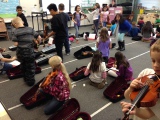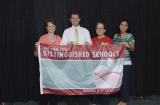-
Category 2
Selected in 2013
-
Grades: k - 6
School Setting: suburban
Town Population: 70,000
Student Enrollment: 450
Student Demographics:
Black/African American: 1%
Teacher/Student Ratio: 1:27
White/Caucasian: 52%
Hispanic: 32%
Hawaiian/Pacific Islander: 4%
Asian: 7%
Native American: 4%
Other: 0%
% Reduced Lunch: 68%
% ELL Learners: 24%
Founded: 1949 -
PRINCIPAL:
Dr. Stephen Oliverson -
CONTACT:
629 South 1000 East
Provo, UT 84606
801-374-4960
steveo@provo.edu
Provost Elementary
Provo, UT
Employees need to feel valued and trusted--not micro-managed and over evaluated. A top-down, one-size-fits-all leadership mentality, or politically based decision making, will diminish the chance for success over time.
- Describe specific programs in place to ensure that families are involved in the success of your school and students.
- We run several successful parent nights throughout the year, focusing on topics such as literacy, homework tips, family fitness, technology, etc. We always have prizes, surveys, and take-home items!
- Describe the most successful activity your school has initiated to strengthen ties to your community.
- Expanding parent nights and parent run programs like Great Artists, Great Writers, grade-level specialized enrichment, reading and math support, all provided through our PTA using very capable human resources from our own community. Provost gets a huge number of volunteer hours each month, with most of this time directly impacting student achievement through parent involvement.
- Describe your philosophy of school change or improvement.
- A winning school/community culture of success needs to be carefully maintained. Employees need to feel valued and trusted--not micro-managed and over evaluated. A top-down, one-size-fits-all leadership mentality, or politically based decision making will diminish teacher motivation and the chance for greater success over time.
- What are your school’s top two goals for the next year?
- Expand our arts programs, and create more ways to extend student thinking.
- What is the single most important factor in the success of your school that others could replicate?
- Many times in the rush to improve academic achievement, district, state, and even federal bureaucracies tend to forget what helps make happy teachers. High teacher turnover rates and low job satisfaction make for dysfunctional schools. Provost has been successful in retaining quality, experienced teachers, which in-turn creates a culture of success and teamwork.
- Describe the program or initiative that has had the greatest positive effect on student achievement, including closing achievement or opportunity gaps, if applicable.
-
It is a combination of many things, but our emphasis on the arts at Provost has paid so many academic dividends. Every classroom gets dance instruction on a weekly basis, where movement is used to teach core academic concepts.
All students who complete seven years at Provost know how to play piano, violin, flute, and guitar. This huge music initiative helps students learn not only music at a deep level, but skills in concentration, collaboration, and critical thinking.
We also have several ways students get visual arts training--one being from our own PTA as they visit classrooms prepared to teach art lessons about great artists, and then have students try the same techniques.
Provost also uses storytelling festivals to allow students the opportunity to express themselves through literary preparation. - Explain how Title I funds are used to support your improvement efforts.
- Title I funding offers us the ability to do a wide variety of things from giving targeted remedial instruction, lowering class size in critical areas, or helping us obtain needed technology.
- Identify the critical professional development activities you use to improve teaching and student learning.
- We feel it is important to (as much as possible), go through professional development as a whole faculty. This builds team work, trust, and a vertical understanding of each grade level's challenges. As a faculty team, we have had two years of formal ELL training, two years or formal math training, RTI, technology, literacy, arts, and classroom management training.
- Describe how data is used to improve student achievement and inform decision making.
-
We progress monitor all students, with the frequency of assessment linked directly to their academic level. We use a three tier model of remediation, and also utilize teacher referrals for homework assist. We tie-in our before and after school programs to target areas of needed student remediation as well.
Teachers review grade level data in Professional Learning Communities on at least a weekly basis, and change academic groupings according to need. - Describe your school culture and explain changes you’ve taken to improve it.
-
Our school theme is "I'm going to college--no excuses!" and we take this challenge very seriously. We really believe ALL of our students WILL be going to college, and frequently associate what they do on a daily basis at school as a preparation for future educational steps. We have done a good job of getting our parents and students to buy into this narrative--and we have more parents that ever talking to their students about "where they want to go to college and what they want to study." We typically refer to rooms as college names--not numbers!
We also run many student-directed achievement based programs and initiatives that allow students to stretch themselves academically "if they choose to do so." Great Brain projects, math challenges, writing challenges, art challenges, science challenge, etc., are all programs that students prepare for on their own time, and the school rewards those who do!
Stats
-
Category 2
Selected in 2013
-
Grades: k - 6
School Setting: suburban
Town Population: 70,000
Student Enrollment: 450
Student Demographics:
Black/African American: 1%
Teacher/Student Ratio: 1:27
White/Caucasian: 52%
Hispanic: 32%
Hawaiian/Pacific Islander: 4%
Asian: 7%
Native American: 4%
Other: 0%
% Reduced Lunch: 68%
% ELL Learners: 24%
Founded: 1949 -
PRINCIPAL:
Dr. Stephen Oliverson -
CONTACT:
629 South 1000 East
Provo, UT 84606
801-374-4960
steveo@provo.edu













